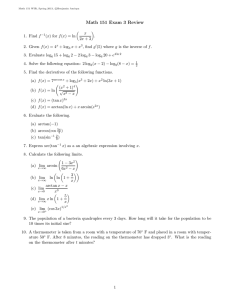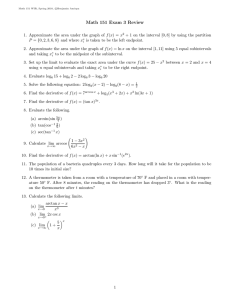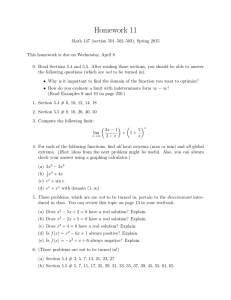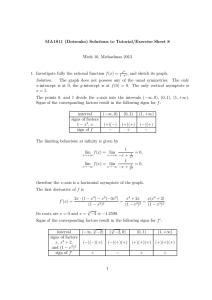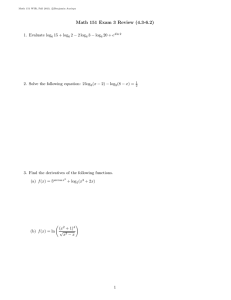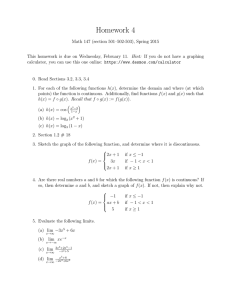Document 10499255
advertisement
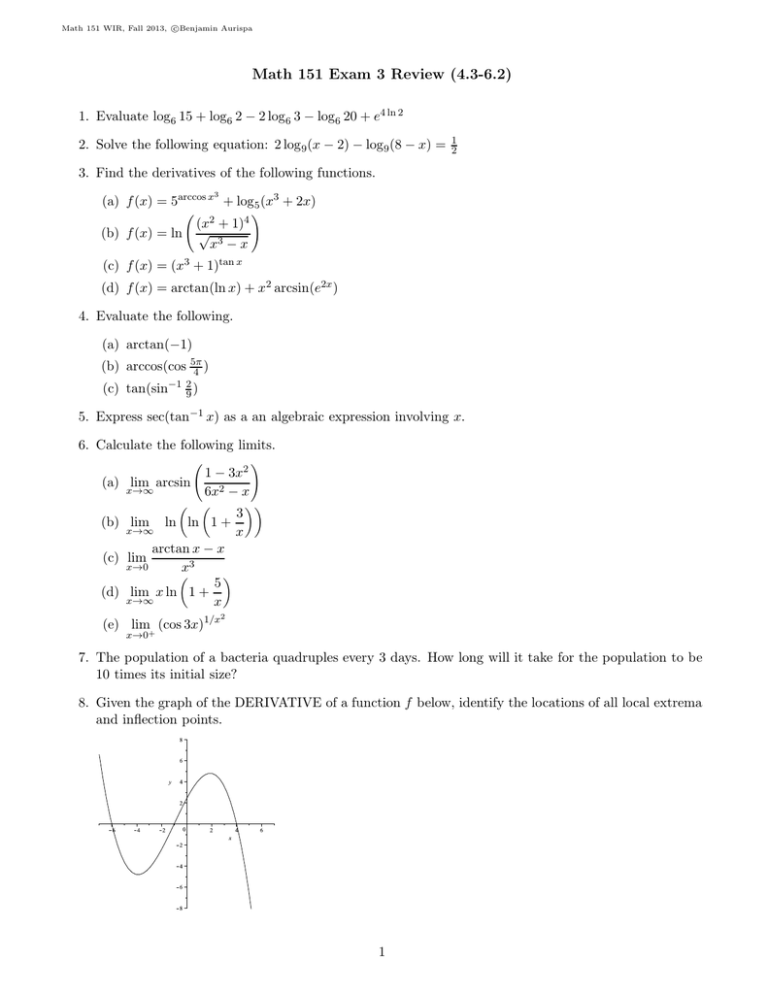
c
Math 151 WIR, Fall 2013, Benjamin
Aurispa
Math 151 Exam 3 Review (4.3-6.2)
1. Evaluate log6 15 + log6 2 − 2 log6 3 − log6 20 + e4 ln 2
2. Solve the following equation: 2 log9 (x − 2) − log9 (8 − x) =
1
2
3. Find the derivatives of the following functions.
3
(a) f (x) = 5arccos x + log5 (x3 + 2x)
(b) f (x) = ln
(x2 + 1)4
√
x3 − x
!
(c) f (x) = (x3 + 1)tan x
(d) f (x) = arctan(ln x) + x2 arcsin(e2x )
4. Evaluate the following.
(a) arctan(−1)
(b) arccos(cos 5π
4 )
(c) tan(sin−1 29 )
5. Express sec(tan−1 x) as a an algebraic expression involving x.
6. Calculate the following limits.
(a) lim arcsin
x→∞
(b) lim
x→∞
1 − 3x2
6x2 − x
ln ln 1 +
arctan x − x
x3
5
(d) lim x ln 1 +
x→∞
x
3
x
!
(c) lim
x→0
(e) lim+ (cos 3x)1/x
2
x→0
7. The population of a bacteria quadruples every 3 days. How long will it take for the population to be
10 times its initial size?
8. Given the graph of the DERIVATIVE of a function f below, identify the locations of all local extrema
and inflection points.
1
c
Math 151 WIR, Fall 2013, Benjamin
Aurispa
9. Find the critical numbers of the function f (x) = (x − 2)1/7 x2 .
10. Find the absolute maximum and minimum values of the following functions on the given interval.
1
(a) f (x) = (5 +
on the interval 7 , 1
e
2
(b) f (x) = sin x + cos x on the interval [0, 3π
4 ]
ln x)4
11. For the function f (x) = 15x4 − x5 , find the intervals where f is increasing/decreasing, the x-values of
any local extrema, intervals of concavity, and the x-values of any inflection points.
2
12. For the function f (x) = xex +3x , find the intervals where f is increasing/decreasing and the x-values
of any local extrema.
√
(9 − x)
x−4
13. Given that f (x) =
, find the intervals where f is increasand f ′ (x) = √
(x + 1)
2 x − 4(x + 1)2
ing/decreasing and the x-values of any local extrema.
14. A box with an open top is to be constructed so that it has a volume of 400 ft3 . If the height of the
box is to be twice its width, find the dimensions of the box with minimum surface area.
15. Find the point on the parabola y = 21 x2 which is closest to the point (5, 1).
16. Find the most general antiderivative of f (x) =
17. Find f (x) if f ′ (x) =
6
x
√
1
3
3
+ sin x + x7 .
x+ 5 + √
x
1 − x2
+ ex − 4 and f (1) = 6.
18. If the acceleration of a particle is given by a(t) =< cos t, t >, find the position function r(t) if it is
known that v(0) =< 2, 3 > and r(0) =< 1, 1 >.
19. Approximate the area under the graph of f (x) = x2 + 1 on the interval [0, 8] by using the partition
P = {0, 2, 3, 6, 8} and taking x∗i is taken to be the left endpoint.
20. Approximate the area under the graph of f (x) = ln x on the interval [1, 11] using 5 equal subintervals
and taking x∗i to be the midpoint of the subinterval.
21. Approximate the area under the graph of f (x) = cos x + 2 on the interval [0, 3π
2 ] by using 6 equal
subintervals and taking x∗i to be the right endpoint.
22. Set up a limit to find the exact area under the curve f (x) = 36 − x2 between x = 2 and x = 5.
23. Calculate the following sums.
(a)
6
X
i=3
(b)
50
X
i=5
(2i − 1)
(ei+1 − ei )
2
